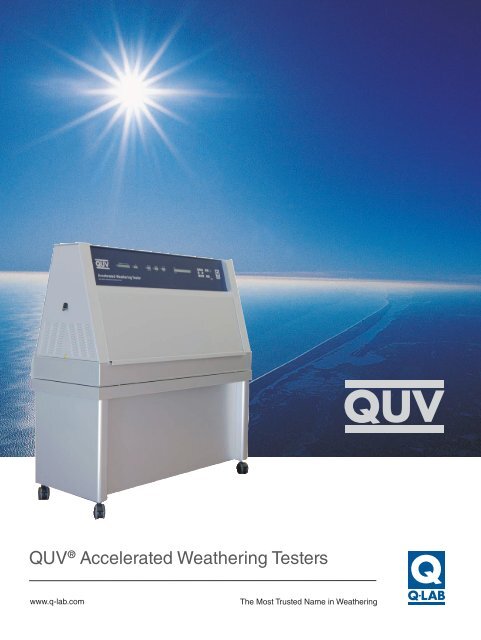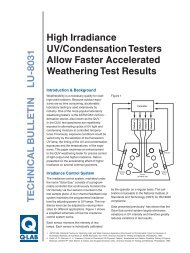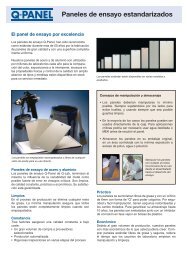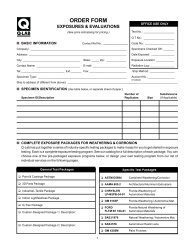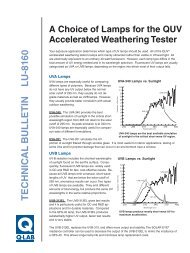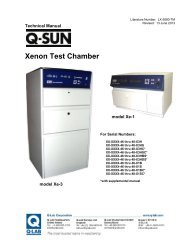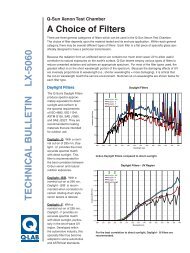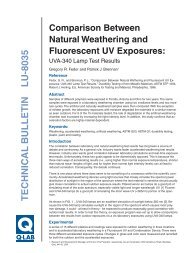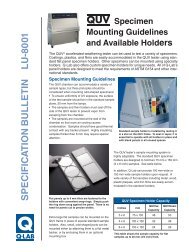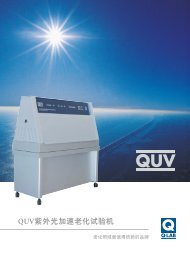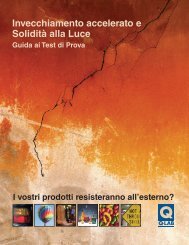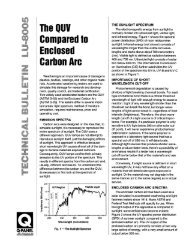QUV Brochure - Q-Lab
QUV Brochure - Q-Lab
QUV Brochure - Q-Lab
You also want an ePaper? Increase the reach of your titles
YUMPU automatically turns print PDFs into web optimized ePapers that Google loves.
<strong>QUV</strong> ® Accelerated Weathering Testers<br />
www.q-lab.com<br />
The Most Trusted Name in Weathering
Why Test?<br />
Meet Specifications<br />
✴ Meet customer requirements<br />
✴ Stay ahead of government regulations<br />
Prevent Field Failures<br />
✴ Improve quality and durability<br />
✴ Enhance reputation<br />
✴ Assure product performance<br />
Gain a Competitive Edge<br />
✴ Save on material costs<br />
✴ Expand product lines<br />
✴ Enter new markets<br />
✴ Outrun the competition<br />
About Q-<strong>Lab</strong><br />
Established in 1956, Q-<strong>Lab</strong> Corporation<br />
is a global provider of products and<br />
services to help manufacturers test the<br />
weatherability, light stability, or corrosion<br />
resistance of their products for industrial,<br />
commercial, government, and consumer<br />
markets. Our headquarters and manufacturing<br />
facility is in Cleveland, Ohio<br />
(USA). Q-<strong>Lab</strong> offices and technology<br />
centers are located in Saarbrücken,<br />
Germany; Bolton, England; and Shanghai,<br />
China. Q-<strong>Lab</strong> also is supported by a<br />
worldwide network of highly<br />
technical sales representatives.<br />
The quality, economy and reliability of<br />
Q-<strong>Lab</strong>’s products and services have established<br />
the company’s reputation as “The<br />
Most Trusted Name in Weathering.”<br />
The World’s Most<br />
Widely Used<br />
Weathering<br />
Tester<br />
2
Will Your Product Last Outdoors?<br />
Find Out Fast With the <strong>QUV</strong> Weathering Tester<br />
Sunlight and moisture cause millions of dollars of material<br />
damage every year. The <strong>QUV</strong> Accelerated Weathering Tester<br />
reproduces the damage caused by sunlight, rain and dew. In a<br />
few days or weeks, the <strong>QUV</strong> can reproduce the damage that<br />
occurs over months or years outdoors.<br />
Don’t Guess When You Can Test<br />
The <strong>QUV</strong> tests materials by exposing them to alternating<br />
cycles of UV light and moisture at controlled, elevated<br />
temperatures. The <strong>QUV</strong> simulates the effects of sunlight with<br />
fluorescent ultraviolet (UV) lamps, and it simulates dew and<br />
rain using condensing humidity and/or water spray. Types of<br />
damage include color change, gloss loss, chalking, cracking,<br />
crazing, hazing, blistering, embrittlement, strength loss and<br />
oxidation.<br />
Realistic<br />
The <strong>QUV</strong> with the UVA-340 lamp produces the most realistic<br />
simulation of sunlight in the short wavelength portion of the<br />
spectrum. The result is a tester that provides excellent correlation<br />
with outdoor tests.<br />
Affordable<br />
The <strong>QUV</strong> is surprisingly economical, both to purchase and to<br />
operate. This is a result of the <strong>QUV</strong>’s efficient design, which<br />
incorporates low cost fluorescent UV lamps for sunlight<br />
simulation and ordinary tap water for condensation.<br />
Easy to Operate<br />
The <strong>QUV</strong>’s simple, yet sophisticated design makes it easy to<br />
install, easy to use, and almost maintenance-free. The <strong>QUV</strong><br />
operates completely automatically, 24 hours a day, 7 days a<br />
week.<br />
✴ ✴ Simple user interface for easy programming<br />
✴ ✴ Exposure conditions are displayed continuously<br />
✴ ✴ Self-diagnostic warnings and service reminders<br />
✴ ✴ Quick calibration with patented AUTOCAL system<br />
The <strong>QUV</strong> is engineered to be completely user<br />
serviceable, with easy access to all parts. This virtually<br />
eliminates the need for service calls and helps<br />
keep operating costs low.<br />
Simplicity Is the<br />
Ultimate Sophistication<br />
The <strong>QUV</strong> is legendary for its ease of use and<br />
reliability. The <strong>QUV</strong> is designed to eliminate the<br />
perennial complaints against complicated weathering<br />
testers: confusing to operate, too many<br />
subsystems to break down, too much downtime,<br />
difficult maintenance and troubleshooting,<br />
expensive parts and service calls.<br />
The World Standard in Weathering<br />
With thousands of testers in service<br />
worldwide, the <strong>QUV</strong> is the world standard for<br />
accelerated laboratory weathering.<br />
The <strong>QUV</strong> complies with a wide range of international,<br />
national, and industry specifications,<br />
ensuring the reliability and reproducibility of<br />
your test program.<br />
3
Irradiance (W/m 2 /nm)<br />
1.2<br />
1.0<br />
0.8<br />
0.6<br />
0.4<br />
0.2<br />
Direct Sunlight<br />
UVA-340<br />
0.0<br />
260 280 300 320 340 360 380 400<br />
Wavelength (nm)<br />
The UVA-340 spectrum is the best available simulation<br />
of sunlight in the UV region, where most of the<br />
damage to durable materials occurs.<br />
1.2<br />
1.0<br />
Lamp Spectra<br />
UV & Sunlight Simulation<br />
UV light is responsible for almost all<br />
photodegradation of durable materials<br />
exposed outdoors. The <strong>QUV</strong>’s fluorescent<br />
lamps simulate the critical short-wave UV<br />
and reproduce the physical property<br />
damage caused by sunlight. Several different<br />
types of UV lamps are available for different<br />
applications. See Q-<strong>Lab</strong> Bulletin LU-8160,<br />
Choice of Lamps for application guidelines.<br />
<strong>QUV</strong> Lamps<br />
Q-<strong>Lab</strong> supplies the highest quality UV<br />
fluorescent lamps available. The technology<br />
behind the lamps produces a spectrum that<br />
is inherently stable throughout their use.<br />
Each manufacturing lot is required to pass a<br />
stringent series of tests before it is approved<br />
for sale. The result is that the <strong>QUV</strong> provides<br />
a consistent, stable spectrum, year after year.<br />
Irradiance (W/m 2 /nm)<br />
0.8<br />
0.6<br />
0.4<br />
0.2<br />
UVB-313<br />
Direct Sunlight<br />
0.0<br />
260 280 300 320 340 360 380 400<br />
Wavelength (nm)<br />
UVB-313 exposures may be useful for testing very<br />
durable materials, such as automotive coatings or<br />
roofing materials.<br />
The <strong>QUV</strong>’s fluorescent<br />
lamps simulate the shortwave<br />
UV energy from<br />
sunlight to reproduce<br />
the polymer degradation<br />
your product experiences<br />
outdoors.<br />
UVA-340 Lamps<br />
The UVA-340 lamps give an excellent<br />
simulation of sunlight in the critical short<br />
wavelength region from 365 nm down to<br />
the solar cut-off of 295 nm.<br />
UVB-313 Lamps<br />
The UVB-313 lamps maximize acceleration<br />
utilizing short-wave UV that is more severe<br />
than the UV normally found at the earth’s<br />
surface. Consequently, these lamps may produce<br />
unrealistically severe results for some<br />
materials. UVB-313 lamps are most useful<br />
for QC and R&D applications, or for testing<br />
very durable materials.<br />
Fluorescent Lamp Advantages<br />
✴ Fast results<br />
✴ Stable light spectrum<br />
✴ Simplified irradiance control<br />
✴ Minimal maintenance<br />
✴ Long lamp life<br />
✴ Low price and operating cost<br />
4
SOLAR EYE ® Irradiance Control<br />
Changes in light intensity may affect the speed of material degradation.<br />
Changes in spectrum may affect both speed and type<br />
of degradation. Therefore, a weathering tester must control<br />
irradiance to achieve reproducible test results.<br />
The SOLAR EYE System<br />
Most <strong>QUV</strong> models are equipped with SOLAR EYE Irradiance<br />
Control. The SOLAR EYE is a precision control system that automatically<br />
maintains light intensity through a feedback loop.<br />
The controller monitors UV intensity and compensates for<br />
lamp aging or any other variability by adjusting power to the<br />
lamps. The SOLAR EYE system allows better reproducibility<br />
and repeatability than manual irradiance control systems.<br />
SOLAR EYE<br />
Controls Irradiance<br />
✴ Monitors light intensity<br />
✴ Maintains preprogrammed intensity<br />
✴ Maximizes repeatability & reproducibility<br />
Extends Lamp Life<br />
✴ Operates lamps until set point cannot be<br />
maintained<br />
✴ Reduces maintenance<br />
Accelerates Results<br />
✴ Maximizes effects with high irradiance<br />
✴ Operates at 75% higher irradiance than<br />
noon, summer sunlight<br />
The operator selects the desired<br />
irradiance level. The level selected<br />
is the “set point.”<br />
How It Works: SOLAR EYE Irradiance Control<br />
With the SOLAR EYE’s automatic feedback loop system, the irradiance is continuously<br />
monitored and precisely maintained.<br />
Both the set point and the actual irradiance<br />
are continuously displayed<br />
for each pair of lamps.<br />
During the UV<br />
cycle, built-in<br />
sensors measure<br />
the light<br />
from each pair<br />
of lamps and<br />
transmit this<br />
data to the<br />
controller.<br />
UV Sensors<br />
Controller<br />
Power Supply<br />
1 3<br />
UV Sensors<br />
2<br />
4<br />
The controller<br />
compares the<br />
measured irradiance<br />
to the set<br />
point.<br />
Then the controller<br />
instructs the<br />
power supply to<br />
adjust the current<br />
to the lamps to<br />
maintain the set<br />
point.<br />
The SOLAR EYE’s UV sensors are<br />
located in the specimen mounting<br />
plane.<br />
Base Cabinet<br />
5
Irradiance Calibration<br />
CR-10 Calibration Radiometer<br />
The CR-10 is an essential accessory to the <strong>QUV</strong>’s SOLAR EYE<br />
system because it ensures the accuracy of the SOLAR EYE and,<br />
ultimately, the <strong>QUV</strong> test results. One CR-10 radiometer can<br />
calibrate any number of <strong>QUV</strong>s.<br />
AUTOCAL Calibration<br />
Calibrating the SOLAR EYE system takes only seconds and is<br />
so easy to perform that there is little chance for operator error.<br />
A warning light shows when it is time to calibrate. The patented<br />
AUTOCAL system automatically transfers the calibration<br />
information from the radiometer to the <strong>QUV</strong>’s SOLAR EYE<br />
controller.<br />
CR-10 Recalibration<br />
The CR-10 should be sent back to Q-<strong>Lab</strong> for recalibration annually<br />
to ensure NIST traceability and ISO compliance.<br />
Temperature Control<br />
The <strong>QUV</strong> precisely controls temperature<br />
to enhance accuracy and accelerate<br />
test results.<br />
Ease of Use<br />
Easy to Operate<br />
✴ Fully automatic operation 24/7<br />
✴ User-friendly programming<br />
✴ Built-in microprocessor<br />
✴ Continual irradiance monitoring<br />
and control<br />
Easy to Maintain<br />
✴ Fast, error-free AUTOCAL calibrations<br />
✴ CR-10 recalibration ensures accuracy<br />
Easy to Service<br />
✴ User-serviceable, no need for expensive<br />
service calls<br />
✴ Self-diagnostic error checking<br />
✴ Continuous system monitoring<br />
✴ Easy-to-read status messages<br />
The patented AUTOCAL<br />
system electronically<br />
transfers the calibration<br />
information from the CR-10<br />
to the SOLAR EYE Irradiance<br />
Controller, ensuring<br />
accuracy.<br />
UV Cycle<br />
Although temperature does not<br />
normally affect the primary photochemical<br />
reaction, it does affect the<br />
rate of any subsequent reactions. Therefore, the <strong>QUV</strong>’s ability<br />
to control temperature is essential during UV exposure.<br />
Moisture Cycle<br />
Because materials can stay wet outdoors for an average of 8-12<br />
hours per day, it is difficult to accelerate moisture attack in a<br />
laboratory tester. The <strong>QUV</strong>’s moisture cycles are conducted at<br />
elevated temperatures to increase the severity and accelerate the<br />
damaging effects of moisture.<br />
Calibrations with the CR-10 Radiometer are<br />
quick, easy and reliable. In just a few seconds,<br />
you can calibrate for ISO compliance.<br />
6
Moisture Simulation<br />
The <strong>QUV</strong> allows two approaches to moisture simulation. For<br />
most applications, condensing humidity is the best way to<br />
simulate outdoor moisture attack. All <strong>QUV</strong> models allow a<br />
programmed condensation cycle. Because certain applications<br />
also require water spray to achieve realistic results, some <strong>QUV</strong><br />
models can produce both condensation and water spray.<br />
Condensation<br />
In many outdoor environments, materials are wet more than<br />
12 hours each day. Research indicates that the main cause of<br />
this outdoor wetness is dew, not rain. The <strong>QUV</strong> simulates<br />
this using a unique condensation mechanism. During the<br />
condensation cycle, a water reservoir in the bottom of the test<br />
chamber is heated to produce vapor. The hot vapor maintains<br />
the chamber at 100% relative humidity, at an elevated<br />
temperature.<br />
The <strong>QUV</strong> is designed so that test specimens form the<br />
external walls of the chamber. Thus, the reverse side<br />
of the specimens is exposed to ambient room air. This<br />
room-air cooling causes the test surface to drop a few<br />
degrees below the interior vapor temperature, ensuring<br />
that water continually condenses on the specimen surface.<br />
The evaporation process naturally distills the water,<br />
resulting in only pure water collection on specimens<br />
even when ordinary tap water is used.<br />
Water Spray<br />
In some service environments, material temperatures<br />
can suddenly decrease when heat builds up over the<br />
course of a sunny day and a sudden rain shower rapidly<br />
dissipates the heat. The resulting thermal shock is a<br />
challenge for many materials. Some materials are susceptible<br />
to mechanical erosion from rainfall. The <strong>QUV</strong><br />
with water spray is useful for simulating both environments.<br />
Using a unique condensation mechanism,<br />
the <strong>QUV</strong> reproduces dew, the main cause<br />
of outdoor wetness.<br />
Condensation Advantages:<br />
✴ Identical to natural wetness<br />
✴ Elevated temperatures for acceleration<br />
✴ Ordinary tap water input<br />
✴ Condensation is pure water – no spotting or<br />
contamination of sample<br />
✴ Minimal maintenance<br />
<strong>QUV</strong> Cross-Section During Condensation Period<br />
Room Air Cooling<br />
Spray Nozzle<br />
(<strong>QUV</strong>/spray only)<br />
Test Specimen<br />
VAPOR<br />
UV Lamps<br />
Test Specimen<br />
Swing-Up Door<br />
Unlike the condensation system that works effectively<br />
with ordinary tap water, the water spray system requires<br />
laboratory grade pure water. See page 10 for information<br />
on a water re-purification system for the <strong>QUV</strong>/spray.<br />
HEATED WATER<br />
Base Cabinet<br />
Oxygenation Vent<br />
Water Heater<br />
The <strong>QUV</strong> reproduces the effects of outdoor moisture with<br />
pure, warm condensation.<br />
7
The <strong>QUV</strong> Controller<br />
Designed to be both functional and easy to use, the <strong>QUV</strong> controller<br />
includes complete self-diagnostic error checking.<br />
The controller constantly monitors the status and performance of all<br />
systems. It also displays simple warning messages, routine service<br />
reminders or performs safety shutdown, as needed.<br />
Now every <strong>QUV</strong> allows the convenient storage of 10 preprogrammed<br />
test cycles, including ISO and ASTM exposure cycles.<br />
Built-in computerized data logging ensures a quick and easy<br />
connection between your <strong>QUV</strong> and PC or LAN. New automatic<br />
lab temperature sensing records the temperature when<br />
any fault occurs, and displays the information to aid in<br />
troubleshooting.<br />
<strong>QUV</strong> Space Saver Frames<br />
Automatic Data Logging<br />
For quality systems that require documented proof<br />
of test conditions or for independent test labs whose<br />
customers require extensive test documentation, every<br />
<strong>QUV</strong> is equipped with an Ethernet connection. Optional<br />
PC software allows the user to:<br />
✴ Automatically record exposure conditions<br />
✴ Directly transfer data from the <strong>QUV</strong> to a<br />
Windows-based computer<br />
✴ Easily connect to a PC directly or through a LAN<br />
✴ Examine data in either graphical or tabular<br />
format<br />
The <strong>QUV</strong> requires little floor space in crowded labs.<br />
Doors swing up and out of the way for easy access to<br />
the chamber. Where space is at a premium, <strong>QUV</strong>s can<br />
be stacked two-high with Space Saver Frames.<br />
With built-in computerized data logging, compiling and<br />
reviewing your <strong>QUV</strong> data has never been easier.<br />
8
Common <strong>QUV</strong> Test Cycles<br />
The <strong>QUV</strong> conforms to a large number of national,<br />
international and industry specifications,<br />
including but not limited to:<br />
✴ ASTM D4799 ✴ ISO 11507<br />
✴ ASTM D6662 ✴ ISO 4892-3<br />
✴ ASTM G154<br />
✴ SAE J2020<br />
✴ ASTM D4587 ✴ J15 K 5600-7-8<br />
✴ EN 927-6<br />
✴ AATCC TM186<br />
Specimen Mounting<br />
Specimen Holders<br />
✴ 2 flat panels per holder<br />
✴ Standard size 3" x 6" (75 mm x 150 mm)<br />
✴ Mount 3-D parts with special holders<br />
✴ 4"x 6" (100 mm x 150 mm) also available<br />
Specimen Capacity<br />
✴ 48 standard size specimens for <strong>QUV</strong>/se,<br />
<strong>QUV</strong>/spray and <strong>QUV</strong>/cw<br />
✴ 50 standard size specimens for <strong>QUV</strong>/basic<br />
The <strong>QUV</strong> can<br />
accommodate<br />
a variety of 3-D<br />
specimens,<br />
including automotive<br />
parts,<br />
lenses, bottles<br />
and CDs.<br />
Test specimens are mounted on both the front and back side<br />
of the <strong>QUV</strong>, providing a large sample capacity.<br />
Versatile Specimen Mounting<br />
Easy-to-use specimen holders adjust for any thickness up to<br />
3/4" (20 mm) and allow fast, snap-action specimen mounting.<br />
Retaining rings provide positive hold-down and do<br />
not require that test specimens be cut to close tolerance. In<br />
addition, custom holders are available for mounting various<br />
products, such as lenses and 3-D components.<br />
9
<strong>QUV</strong> Models<br />
The <strong>QUV</strong> comes in several models. See the LU-0819<br />
specification sheet for comparative capabilities.<br />
Model <strong>QUV</strong>/se<br />
The most popular <strong>QUV</strong> model features the SOLAR<br />
EYE Irradiance Control for precise maintenance of UV<br />
light intensity. The <strong>QUV</strong>/se uses a proven condensation<br />
mechanism to simulate outdoor moisture attack.<br />
It allows faster, more reproducible testing, longer lamp<br />
life, and ISO calibration. With the <strong>QUV</strong>/se, state-ofthe-art<br />
accelerated weathering is available in an<br />
affordable tester that is easy to use.<br />
Model <strong>QUV</strong>/spray<br />
The <strong>QUV</strong>/spray is the same as a standard <strong>QUV</strong>/se, but<br />
also includes a water spray system consisting of spray<br />
nozzles, piping, controls and drain.<br />
Irradiance (W/m 2 /nm)<br />
1.8<br />
1.6<br />
1.4<br />
1.2<br />
1.0<br />
0.8<br />
0.6<br />
UVA-340 @ Maximum<br />
Irradiance<br />
(1.55 W/m 2 @ 340 nm)<br />
Direct Sunlight<br />
0.4<br />
UVA-340 @ Normal<br />
0.2<br />
Irradiance<br />
(0.68 W/m 2 @ 340 nm)<br />
0.0<br />
280 290 300 310 320 330 340 350 360 370 380 390 400<br />
Wavelength (nm)<br />
The SOLAR EYE Irradiance Control enables users<br />
to increase light intensity for maximum acceleration.<br />
Short periods of spray can be used to create a thermal<br />
shock. Longer periods can be used to achieve mechanical<br />
erosion. The <strong>QUV</strong>/spray can be set to produce<br />
the following conditions: UV alone, spray alone, or<br />
condensation. Deionized water is recommended for<br />
most spray applications.<br />
Research indicates that dew, not rain, is the<br />
main cause of outdoor wetness. All <strong>QUV</strong><br />
models use condensation to simulate outdoor<br />
moisture.<br />
Optional Water<br />
Repurification System<br />
In addition to condensation, the <strong>QUV</strong>/spray<br />
can be programmed to produce water spray<br />
for thermal shock and/or surface erosion.<br />
10<br />
Some tests using the <strong>QUV</strong> water spray<br />
system consume large amounts of purified<br />
water. The costs of water purification for<br />
these tests can add up quickly. Q-<strong>Lab</strong> offers<br />
an optional system that repurifies spray water<br />
that has already been purified with an<br />
external system. This system can reduce the<br />
cost of purifying the <strong>QUV</strong>’s water supply<br />
by 80% or more.
<strong>QUV</strong> Models (continued)<br />
Model <strong>QUV</strong>/basic<br />
This is a simplified version of the <strong>QUV</strong> for the lab where<br />
economy is critical. Irradiance is controlled by periodic lamp<br />
replacement and repositioning. The <strong>QUV</strong>/basic has a condensation<br />
system for moisture simulation. It does not have water<br />
spray.<br />
The <strong>QUV</strong>/basic does not have the SOLAR EYE Irradiance<br />
Control system. Consequently, the light intensity cannot be<br />
adjusted or calibrated. This means the <strong>QUV</strong>/basic cannot be<br />
used for high irradiance testing.<br />
We recommend the <strong>QUV</strong>/basic for comparative exposures<br />
where the test specimens and the control specimens are exposed<br />
at the same time in the same tester.<br />
<strong>QUV</strong> Models<br />
<strong>QUV</strong>/se<br />
✴ SOLAR EYE Irradiance Control<br />
✴ Condensation<br />
✴ ISO calibration<br />
<strong>QUV</strong>/spray<br />
✴ SOLAR EYE Irradiance Control<br />
✴ Condensation<br />
✴ Water spray system<br />
✴ ISO calibration<br />
<strong>QUV</strong>/basic<br />
✴ Economical<br />
✴ Best used for comparative testing<br />
✴ Manual irradiance control<br />
✴ No calibration<br />
<strong>QUV</strong>/cw<br />
✴ SOLAR EYE Irradiance Control<br />
✴ Cool white fluorescent lamps<br />
✴ Indoor photostability testing<br />
✴ ISO calibration<br />
0.5<br />
The <strong>QUV</strong>/basic is recommended for labs<br />
where economy is critical. Irradiance is<br />
controlled by periodic replacement of<br />
lamps.<br />
Model <strong>QUV</strong>/cw<br />
Some industries have test methods that specify the use of<br />
cool white lamps for indoor photostability testing. To reproduce<br />
indoor light conditions, the <strong>QUV</strong>/cw has a SOLAR<br />
EYE Irradiance Control system which has been modified to<br />
monitor and control the light output of cool white fluorescent<br />
lamps. See Q-<strong>Lab</strong> Bulletin LU-0823, <strong>QUV</strong>/cw Cool<br />
White Photostability Tester for more information.<br />
11<br />
Irradiance (W/m 2 /nm)<br />
0.4<br />
0.3<br />
<strong>QUV</strong> with<br />
Cool White<br />
0.2<br />
Lamps<br />
(20 klux)<br />
Cool White<br />
0.1<br />
Lamps in a<br />
Typical Office<br />
(1 klux)<br />
0.0<br />
300 350 400 450 500 550 600 650 700<br />
Wavelength (nm)<br />
The <strong>QUV</strong>/cw uses cool white lamps to simulate indoor<br />
environments, such as the overhead fluorescent<br />
lighting typically found in offices. It also meets ISO,<br />
ANSI and ASTM test methods for indoor photostability<br />
testing.
Q-<strong>Lab</strong> Corporation – The Most Trusted Name in Weathering<br />
Q-<strong>Lab</strong> Corporation is a global provider of material durability testing equipment and<br />
services. For more than 50 years, our goal has been to produce practical, economical,<br />
and reliable products and services for our customers.<br />
Florida Subtropical Weathering is the world standard for natural sunlight and<br />
moisture exposures.<br />
Arizona Desert Weathering has intense sunlight, high temperatures, and large daily<br />
temperature fluctuations.<br />
Q-TRAC ® Natural Sunlight Concentrator is an accelerated outdoor exposure test which<br />
uses natural sunlight as its source.<br />
Q-SUN ® Xenon Test Chamber reproduces the full spectrum of sunlight, including UV,<br />
visible and infrared. It is especially useful for testing dyes, pigments, textiles, inks<br />
and indoor materials.<br />
Accelerated <strong>Lab</strong>oratory Testing at Q-<strong>Lab</strong> Florida offers xenon, <strong>QUV</strong>, humidity,<br />
corrosion and chip resistance testing.<br />
<strong>QUV</strong> Accelerated Weathering Tester provides fast and economical results. Fluorescent<br />
UV lamps provide the best simulation of solar UV. The <strong>QUV</strong> is especially useful for testing<br />
physical properties of polymers and appearance properties of coatings.<br />
Q-<strong>Lab</strong> Corporation<br />
Q-<strong>Lab</strong> Headquarters<br />
& Instruments Division<br />
800 Canterbury Road<br />
Westlake, Ohio 44145 USA<br />
Tel. +1-440-835-8700<br />
Fax +1-440-835-8738<br />
info@q-lab.com<br />
Q-<strong>Lab</strong> Europe, Ltd.<br />
Express Trading Estate<br />
Stone Hill Rd, Farnworth<br />
Bolton, England<br />
Tel. +44 (0) 1204-861616<br />
Fax +44 (0) 1204-861617<br />
info.eu@q-lab.com<br />
Q-<strong>Lab</strong> Deutschland GmbH<br />
In den Hallen 30<br />
Saarbrücken, Deutschland<br />
Tel. +49 (0) 681 85747-0<br />
Fax +49 (0) 681 8574074<br />
vertrieb@q-lab.com<br />
Q-<strong>Lab</strong> China<br />
Room 1001, Yong Ding Building<br />
No. 3388 Gong He Xin Rd<br />
Shanghai, China<br />
电 话 :+86-21-58797970<br />
传 真 :+86-21-58797960<br />
info.cn@q-lab.com<br />
Q-<strong>Lab</strong> Weathering<br />
Research Service<br />
Q-<strong>Lab</strong> Florida<br />
P.O. Box 349490<br />
1005 SW 18th Avenue<br />
Homestead, FL USA<br />
Tel. +1-305-245-5600<br />
Fax: +1-305-245-5656<br />
info@q-lab.com<br />
Exposure Racks at Q-<strong>Lab</strong> Florida<br />
Q-SUN Xenon Test Chamber<br />
Q-TRAC at Q-<strong>Lab</strong> Arizona<br />
Q-<strong>Lab</strong> Arizona<br />
24742 West Durango Street<br />
Buckeye, AZ USA<br />
Tel. +1-623-386-5140<br />
Fax: +1-623-386-5143<br />
info@q-lab.com<br />
Q-PANEL, <strong>QUV</strong>, Q-<strong>Lab</strong>, Q-SUN,<br />
Q-TRAC, AUTOCAL & SOLAR EYE<br />
are trademarks of Q-<strong>Lab</strong> Corporation.<br />
© 2011 Q-<strong>Lab</strong><br />
Corporation<br />
LU-0801.7<br />
www.q-lab.com<br />
The Most Trusted Name in Weathering


